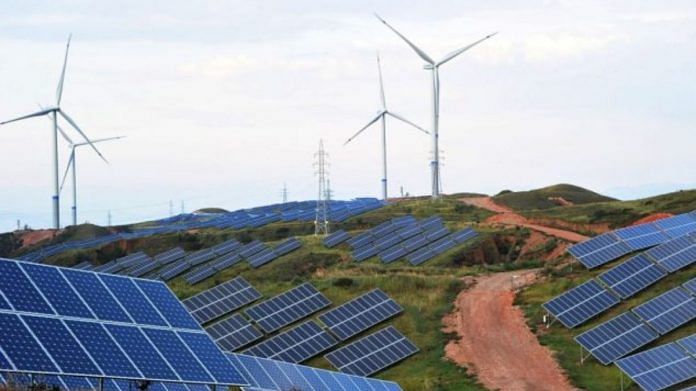
New Delhi: Renewable energy investments in India are starting to recover after a Covid-19 induced dip in 2020-2021, an analysis by the Institute for Energy Economics and Financial Analysis (IEEFA) has shown.
In the pandemic year of 2020-2021, investments in the sector tanked by 24 per cent, from $8.4 billion (around Rs 59,000 crore) in 2019-20 to $6.4 billion (Rs 45,000 crore).
However, the first four months of 2021-22 are starting to show signs of recovery, with investments going up to $6.6 billion (Rs 46,000 crore) in April-July. This growth is riding on the “revival of energy demand and commitments from various banks and financial institutions to exit fossil fuel investments”, the IEEFA found.
“Rebounding energy demand and a surge of commitments from banks and financial institutions to exit fossil fuel financing are helping to drive investment into Indian renewable energy infrastructure,” Vibhuti Garg, lead author of the report, said in a statement.
India has committed to producing 450 gigawatts (GW) of renewable energy by 2030, which will cost $500 billion (Rs 35 trillion) in investments — $300 billion (Rs 21 trillion) for wind and solar infrastructure, $50 billion (Rs 3.5 trillion) for grid firming investments, and $150 billion (Rs 10.5 trillion) on expanding and modernising transmission.
“Daunting in one respect, but the financial trends in Indian renewable energy and grid infrastructure over the last 2-3 years strongly suggest domestic and global capital is ready, willing and enabled to support this ambition,” the analysis said.
India’s RE landscape
Most of the money for the new investments came from acquisitions.
“The largest deal was SoftBank Energy’s exit from the Indian Renewable Energy sector with a sale of assets worth $3.5 billion. This was followed by the Engie, ACME and Fortum deals. Further analysis shows the investment deal type, with the majority of the other biggest deals packaged as debt, equity investment or green bonds, followed by mezzanine funding,” the analysis said.
Lending portfolios of the State Bank of India and Power Finance Corporation have expanded to include more renewable energy assets than fossil fuels, “a trend which has picked up significantly in the last one to two years”, it said.
“Further, Indian developers are attracting huge investments from green bonds. In April 2021, ReNew Power raised money from green bonds with a tenor of 7.25 years at a fixed interest rate of 4.5% per annum, and this was soon trumped in August 2021 by the US$414m 2026 green bond issue by Azure Power Global at a record low 3.575% per annum,” it added.
Massive investment still needed
India is currently investing around $18-20 billion (Rs 1.3-1.4 trillion) in energy generation capacity and a further $20 billion (Rs 1.4 trillion) in the grid on an annual basis.
To achieve the Sustainable Development Scenario (SDS) in the International Energy Agency’s India Energy Outlook 2021, the country would need to triple its current rate of annual investment to $110 billion, the analysis said.
The SDS explores how India could invest in clean energy to accelerate its sustainable development goals.
In a statement, the report’s lead author, Vibhuti Garg, said, “The decarbonisation of the energy sector will demand massive amounts of investment, and the flow of capital into this space will need to accelerate rapidly in order to meet India’s clean energy targets and enable a green recovery towards a sustainable economy.”
Subscribe to our channels on YouTube & Telegram
Why news media is in crisis & How you can fix it
India needs free, fair, non-hyphenated and questioning journalism even more as it faces multiple crises.
But the news media is in a crisis of its own. There have been brutal layoffs and pay-cuts. The best of journalism is shrinking, yielding to crude prime-time spectacle.
ThePrint has the finest young reporters, columnists and editors working for it. Sustaining journalism of this quality needs smart and thinking people like you to pay for it. Whether you live in India or overseas, you can do it here.